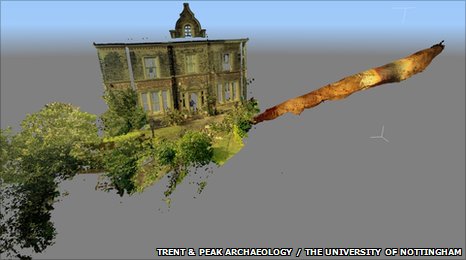When I first saw the magical, Harry-Potter-like images taken by the folks at the Nottingham Caves Survey in England, my jaw clunked on my desk. Archaeologists have enthused for some time now over the potential of laser scanning for recording ancient sites, but until now the results looked merely brisk and workmanlike. But these new 3-D pictures of the secret subterranean world beneath the ancient city of Nottingham are taking this work to a whole new level. These images–like the one above of a secret 14th century passageway leading to Nottingham Castle–resemble works of surrealism and fantasy. But they are pure science.
First, a quick word about Nottingham. Nottingham’s earliest name, given by the Saxons who settled at there in the 6th century, meant “house or place of caves.” And it was a good name. Much of city perches on very soft sandstone bedrock and local people quickly learned to chip away at the stone to create hundreds of subterranean caves and passageways. Some they inhabited as houses; others they turned into beer cellars, tanneries, and cesspits.
Eventually, Nottinghamers began redeveloping their city center, filling in and destroying many of the caves. So a few years back, researchers at Trent & Peak Archaeology, some of whom were avowed cave nuts, decided to create a permanent record on the cheap of what remained. Since it was pricey and difficult to park in the city center, they designed two bicycle-powered trailers to transport their gear around town and set off with their laser scanners. They scanned parts of the underground, as well as the relevant above-ground ruins.
One of the coolest passageways they documented was Mortimer’s Hole, which you can see in the photo above and in the video (highly, highly recommended: don’t be fooled by the bland titlepage) below. The name refers to Roger de Mortimer, a conspirator in the murder of Edward II. Among other things, Mortimer was the lover of Edward’s wife, Queen Isabella, and the de facto ruler of England until the young king Edward III was crowned. Wishing to be rid of this usurper once and for all, Edward ordered his troops to arrest Mortimer in the fall of 1330.
Mortimer was holed up in Nottingham Castle at the time. But according to history, the king’s men breeched the castle’s defences by taking a secret underground passageway. The reddish-brown tunnel leading to the castle in the image above is one leg of this underground route. If you click on the video below, you can follow in the footsteps of the king’s men through the entire tunnel.
These images are rapidly reviving local interest in Nottingham’s subterranean history–a wonderful thing. But I think the real importance of this project transcends Nottingham and its colorful history. These spectacular images–and there are many more here–are a head’s up to archaeologists and all of the rest of us to the power of laser scanning. Imagine if someone produced similar images of the immensely complex cave system at Lascaux or any of the other Paleolithic cave sites.
That would be an eye-opening and jaw-dropping experience, a kind of magic, Hogwarts style.
Photo and Video courtesy of Trent & Peak Archaeology at the University of Nottingham.

Utterly fantastic imagery. This is tremendous.
Wow!!
Honest, I thought that photo was something from the movie. The video in particular was just astounding! Astroporn is going to have to dial it up a notch.
Am so glad to hear you guys agree! I was just blown away by the photos and video. Can’t wait to see what’s next from Nottingham.
Heather,
Thanks so much for the link to the Nottingham Caves Survey. The cave video is amazing and unearthly. I feel like I’ve walked through those caves.
Take care.
Toni
Fascinating- what a wonderful virtual tour! I have visions of assassins winding their way through that cave.